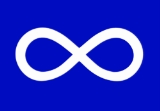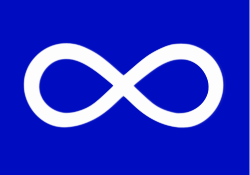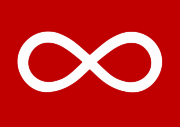
Métis Flag
Encyclopedia


Métis people (Canada)
The Métis are one of the Aboriginal peoples in Canada who trace their descent to mixed First Nations parentage. The term was historically a catch-all describing the offspring of any such union, but within generations the culture syncretised into what is today a distinct aboriginal group, with...
resistance fighters in Canada
Canada
Canada is a North American country consisting of ten provinces and three territories. Located in the northern part of the continent, it extends from the Atlantic Ocean in the east to the Pacific Ocean in the west, and northward into the Arctic Ocean...
prior to the Battle of Seven Oaks
Battle of Seven Oaks (1816)
The Battle of Seven Oaks took place on June 19, 1816, during the long dispute between the Hudson's Bay Company and the North West Company, rival fur-trading companies in western Canada.-Background:Miles Macdonell had issued the Pemmican Proclamation...
in 1816. The flag is either blue or red with a white infinity symbol superimposed on top. The blue flag is used to associate the Métis employees of the North West Company
North West Company
The North West Company was a fur trading business headquartered in Montreal from 1779 to 1821. It competed with increasing success against the Hudson's Bay Company in what was to become Western Canada...
, while the red represents the Métis who worked for the Hudson's Bay Company
Hudson's Bay Company
The Hudson's Bay Company , abbreviated HBC, or "The Bay" is the oldest commercial corporation in North America and one of the oldest in the world. A fur trading business for much of its existence, today Hudson's Bay Company owns and operates retail stores throughout Canada...
(see Anglo-Métis
Anglo-Métis
A 19th-century community of the Métis people of Canada, the Anglo-Métis, more commonly known as Countryborn, were children of fur traders; they typically had Orcadian, Scottish, or English fathers and Aboriginal mothers. Their first languages were generally those of their mothers: Cree, Saulteaux,...
). The symbol represents the mixing of the European
European ethnic groups
The ethnic groups in Europe are the various ethnic groups that reside in the nations of Europe. European ethnology is the field of anthropology focusing on Europe....
immigrants and the First Nations
First Nations
First Nations is a term that collectively refers to various Aboriginal peoples in Canada who are neither Inuit nor Métis. There are currently over 630 recognised First Nations governments or bands spread across Canada, roughly half of which are in the provinces of Ontario and British Columbia. The...
peoples, which creates a new and distinct culture, the Métis.
The blue background flag has been accepted by the Métis National Assembly as the official flag of the Métis Nation of Canada. The red flag now stands as the provincial ensign for the Métis Nation of Alberta.
The white infinity symbol on the flag represents the faith that the Métis culture shall live on forever. It can also be perceived as two conjoined circles, standing for the unity of two cultures, Aboriginal First Nations and European (primarily French). The flag can still be seen in areas in Manitoba
Manitoba
Manitoba is a Canadian prairie province with an area of . The province has over 110,000 lakes and has a largely continental climate because of its flat topography. Agriculture, mostly concentrated in the fertile southern and western parts of the province, is vital to the province's economy; other...
, and other traditional Métis territories such as Batoche and other settlements in Saskatchewan and Alberta, and northern Ontario.
The symbol is drawn from the mark made by Catholic and other missionaries in birth and baptismal church records, beginning in the 1600s, to denote a parent who was Indian.

